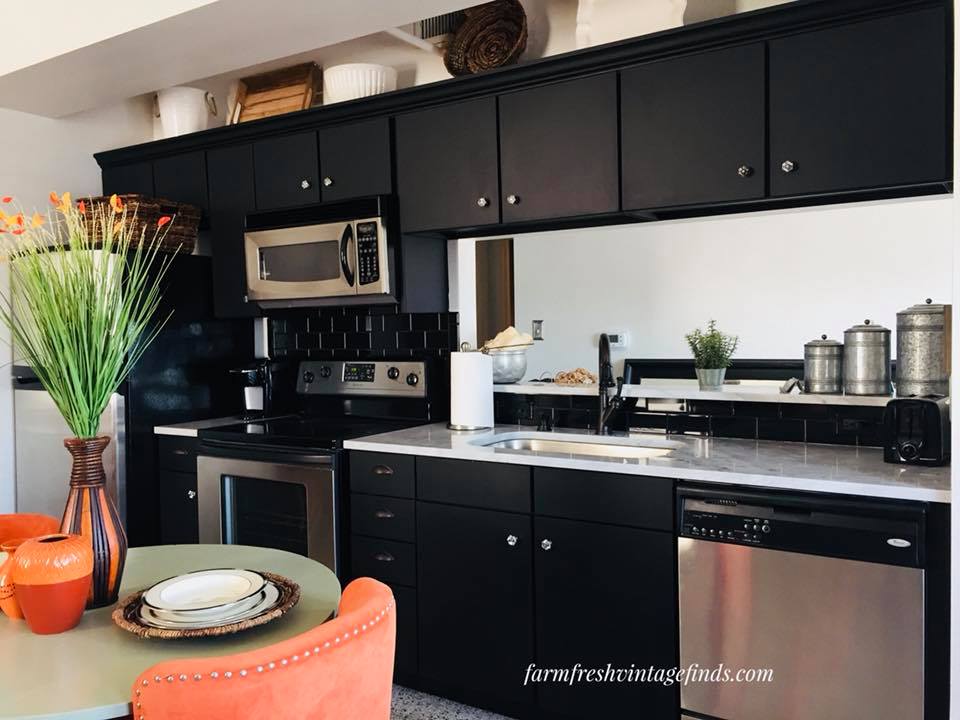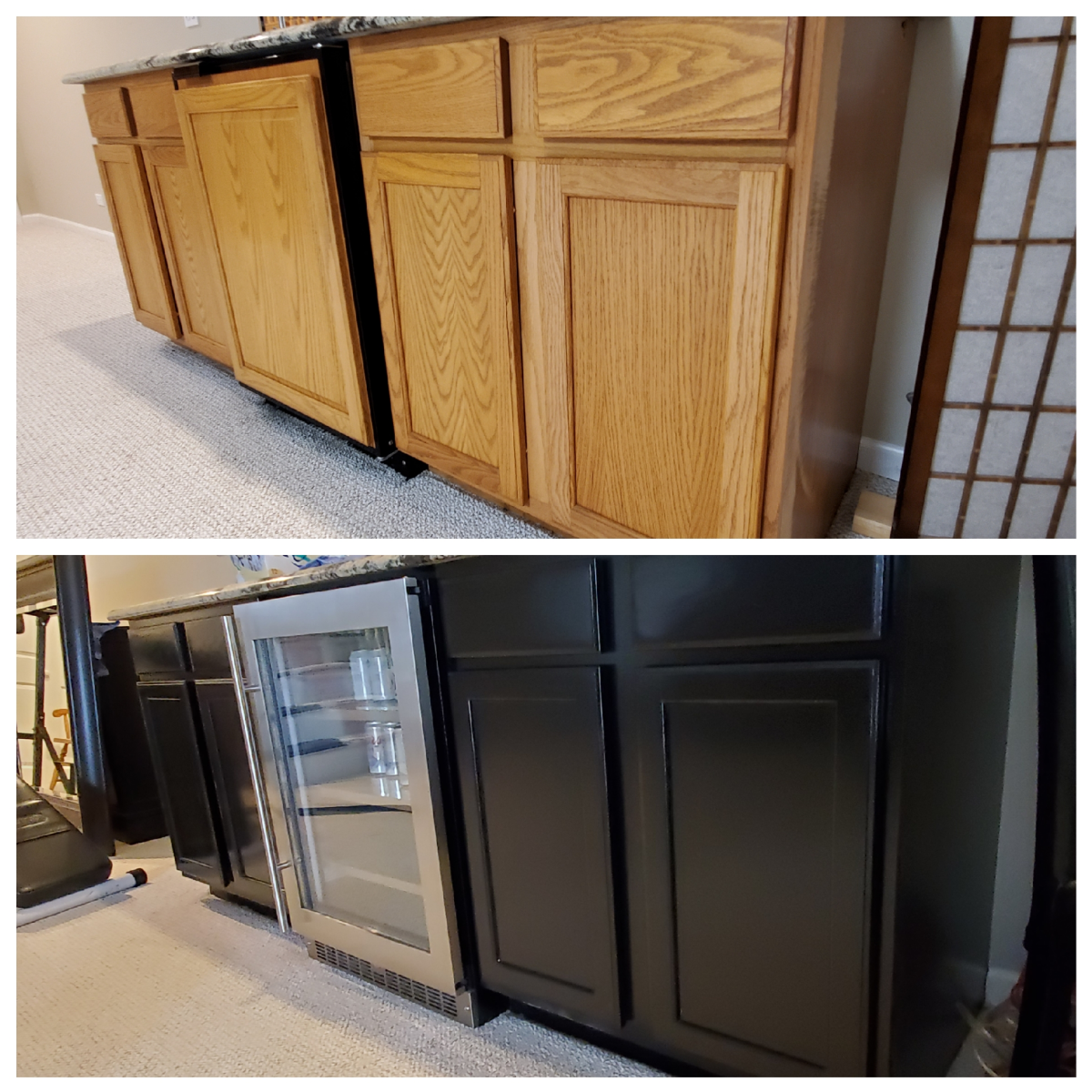Black Milk Paint

Black milk paint is a unique and eco-friendly paint that has been around for centuries. It’s known for its rich history, natural ingredients, and beautiful matte finish.
Properties of Black Milk Paint, Black milk paint cabinets
Black milk paint is a type of paint that uses milk protein as a binder, unlike traditional paints that rely on synthetic polymers. This gives it a unique set of properties:
- Natural and Sustainable: Black milk paint is made from natural ingredients, making it a sustainable and eco-friendly option compared to traditional paints that often contain harmful chemicals.
- Matte Finish: Black milk paint dries to a beautiful matte finish that adds a touch of elegance and sophistication to any surface.
- Distressed Look: Black milk paint has a tendency to chip and crack, creating a unique distressed look that adds character and charm to furniture and other surfaces.
- Durable: Despite its natural ingredients, black milk paint is surprisingly durable and can withstand regular wear and tear.
Black Milk Paint vs. Traditional Paint
Black milk paint stands out from traditional paints in several key ways:
- Ingredients: Black milk paint is made from natural ingredients like milk protein, pigments, and water, while traditional paints typically contain synthetic polymers, solvents, and other chemicals.
- Environmental Impact: Black milk paint is a more environmentally friendly option because it uses natural ingredients and produces fewer harmful emissions during production and application.
- Finish: Black milk paint dries to a matte finish, while traditional paints can have a variety of finishes, including gloss, satin, and semi-gloss.
- Durability: Black milk paint is durable and can withstand regular wear and tear, but it may not be as durable as some traditional paints.
History of Black Milk Paint
Black milk paint has a rich history dating back centuries. It was widely used in the past due to its affordability and availability of ingredients.
- Early Use: Black milk paint was commonly used in the 18th and 19th centuries, particularly in rural areas where milk was readily available. It was used to paint furniture, walls, and other surfaces.
- Decline and Revival: The popularity of black milk paint declined in the 20th century with the advent of synthetic paints. However, in recent years, there has been a revival of interest in this traditional paint due to its eco-friendly nature and unique properties.
Black Milk Paint Cabinets
:max_bytes(150000):strip_icc()/BlackMilkPaintKitchenCabinets-59c026d803f4020010c1205c.png)
Black milk paint cabinets are a trendy and stylish choice for homeowners who want to create a unique and sophisticated look in their homes. The versatility of black milk paint allows it to complement various design styles, from traditional to modern. This paint can be used to transform old cabinets into statement pieces or to create a cohesive and elegant look in a newly renovated space.
Black Milk Paint Cabinets: A Stylish Choice
Black milk paint cabinets offer a timeless elegance that enhances the visual impact of any room. This paint’s versatility allows it to seamlessly integrate into diverse design styles, from traditional to contemporary.
- Traditional: Black milk paint cabinets can add a touch of sophistication to traditional kitchens and bathrooms. They complement classic design elements such as marble countertops, wood floors, and ornate hardware.
- Modern: Black milk paint cabinets can create a sleek and minimalist look in modern spaces. They contrast beautifully with white walls, metallic accents, and geometric patterns.
- Mid-Century Modern: Black milk paint cabinets can add a touch of vintage charm to mid-century modern homes. They complement the warm wood tones, rounded edges, and geometric patterns of this style.
- Industrial: Black milk paint cabinets can create a raw and edgy look in industrial spaces. They pair well with exposed brick walls, metal accents, and reclaimed wood.
- Farmhouse: Black milk paint cabinets can add a touch of rustic charm to farmhouse kitchens and bathrooms. They complement the warm wood tones, distressed finishes, and vintage accents of this style.
Types of Cabinets
Black milk paint can be used to paint a variety of cabinets, including:
- Kitchen Cabinets: Black milk paint can transform outdated kitchen cabinets into sleek and modern statement pieces. They can be paired with white countertops, stainless steel appliances, and wood floors to create a cohesive and elegant look.
- Bathroom Vanities: Black milk paint can create a sophisticated and spa-like atmosphere in bathrooms. They can be paired with marble countertops, white tile, and brass fixtures to create a luxurious and inviting space.
- Built-in Shelves: Black milk paint can add a touch of elegance to built-in shelves. They can be used to create a focal point in a living room or bedroom.
Black Milk Paint Cabinet Styles
Here’s a table showcasing various cabinet styles and how black milk paint can enhance their visual impact:
| Cabinet Style | Black Milk Paint Enhancement |
|---|---|
| Shaker Cabinets | Black milk paint accentuates the clean lines and simplicity of Shaker cabinets, creating a timeless and elegant look. |
| Raised Panel Cabinets | Black milk paint highlights the raised panels, adding depth and dimension to the cabinets. |
| Slab Cabinets | Black milk paint provides a sleek and modern look to slab cabinets, emphasizing their minimalist design. |
| Glass-Front Cabinets | Black milk paint creates a dramatic contrast with the glass fronts, showcasing the contents of the cabinets. |
Applying Black Milk Paint to Cabinets

Applying Black Milk Paint to cabinets is a fun and rewarding project that can transform the look of your kitchen or bathroom. It’s a great option for achieving a unique, distressed, or layered look. The paint’s versatility and durability make it a popular choice for many DIYers. Let’s dive into the steps for a successful paint job.
Preparing Cabinets for Black Milk Paint
Before applying Black Milk Paint, proper preparation is crucial for a smooth and long-lasting finish. This involves sanding, cleaning, and priming.
- Sanding: Start by sanding the cabinets with 120-grit sandpaper to remove any imperfections, dust, or old finishes. This creates a smooth surface for the paint to adhere to. Focus on sanding down any raised areas or rough spots. After sanding, wipe the cabinets down with a damp cloth to remove any dust particles.
- Cleaning: After sanding, clean the cabinets with a mild detergent and water solution. This removes any remaining dirt, grease, or residue that could interfere with the paint’s adhesion. Allow the cabinets to dry completely before proceeding to the next step.
- Priming: Priming is essential for creating a smooth and even surface for the Black Milk Paint to adhere to. Choose a primer specifically designed for your cabinets’ material, whether it’s wood, laminate, or metal. Apply the primer evenly using a brush or roller, and allow it to dry completely before applying Black Milk Paint.
Applying Black Milk Paint to Cabinets
Applying Black Milk Paint to cabinets is a straightforward process, but there are some techniques that can help you achieve a professional-looking finish.
- Applying the First Coat: Apply the first coat of Black Milk Paint using a brush or roller. Use smooth, even strokes, and avoid overloading the brush or roller. Allow the first coat to dry completely before applying subsequent coats.
- Applying Subsequent Coats: Apply additional coats of Black Milk Paint as needed, allowing each coat to dry completely before applying the next. The number of coats needed will depend on the desired coverage and the color of the paint.
- Distressing: To achieve a distressed look, use sandpaper to lightly sand away some of the paint in areas where wear and tear would naturally occur, such as edges, corners, and raised areas. This technique creates a vintage or antique look.
- Layering: For a more complex look, consider layering different colors of Black Milk Paint. Apply a base coat, then allow it to dry completely. Then, apply a second color, using a brush or sponge to create a layered effect.
- Textured Effects: Black Milk Paint can be used to create textured effects. For example, you can apply a coat of paint, then sprinkle on a layer of sand or other textured material before the paint dries. This creates a unique and tactile finish.
Black milk paint cabinets offer a rustic charm, but for a more dramatic and modern aesthetic, consider the striking contrast of navy cabinets with black hardware. This pairing creates a sophisticated depth that complements the natural imperfections of milk paint, making it a winning combination for any kitchen or bathroom.
Black milk paint cabinets offer a unique, aged look that can transform a kitchen. Their distressed finish adds a touch of rustic charm, while their deep black hue creates a dramatic backdrop for pops of color. For those seeking a more classic and timeless aesthetic, a black and white cabinet kitchen is a perfect choice.
The contrast between the dark cabinets and crisp white accents provides a sophisticated and elegant feel. Whether you prefer the rustic charm of black milk paint or the classic elegance of a black and white scheme, both styles can create a kitchen that is both beautiful and functional.
